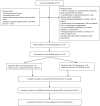The Role of the Subcostal Transversus Abdominis Plane Block in Facilitating Operating Room Extubation After Living Donor Liver Transplantation for Hepatocellular Carcinoma: A Propensity Score-Matching Analysis
- PMID: 40003706
- PMCID: PMC11857526
- DOI: 10.3390/life15020297
The Role of the Subcostal Transversus Abdominis Plane Block in Facilitating Operating Room Extubation After Living Donor Liver Transplantation for Hepatocellular Carcinoma: A Propensity Score-Matching Analysis
Abstract
Background: Effective pain management is essential to early extubation and recovery in living donor liver transplantation (LDLT). The subcostal transversus abdominis plane (TAP) block has emerged as a potential strategy to address postoperative pain while reducing opioid consumption. This study evaluated the effectiveness of the TAP block in facilitating early extubation in the OR and examined its impact on re-intubation rates, postoperative fentanyl requirements, and pain intensity upon ICU admission to determine its role in perioperative pain management. Methods: This retrospective cohort study included adult patients who underwent LDLT for hepatocellular carcinoma within the Milan criteria. Propensity score matching was performed to compare outcomes between patients who received the subcostal TAP block and those who did not. The primary outcome was the rate of successful extubation in the operating room (OR). Secondary outcomes included re-intubation rates, postoperative fentanyl requirements, and peak numeric rating scale (NRS) pain scores upon ICU admission. Results: The subcostal TAP block was associated with a significantly higher rate of successful OR extubation compared with no TAP block. Multivariable analysis revealed that the TAP block independently increased the likelihood of successful extubation. Patients receiving the TAP block required less fentanyl for pain management and demonstrated lower peak NRS pain scores upon ICU admission. No complications related to the TAP block were observed, underscoring its safety in this high-risk population. Conclusions: The subcostal TAP block facilitates early OR extubation by effectively managing postoperative pain and reducing opioid requirements, promoting smoother recovery without increasing adverse events. These findings support its inclusion in multimodal analgesia protocols for optimizing perioperative outcomes in LDLT patients.
Keywords: early extubation; living donor liver transplantation; operating room; subcostal TAP block.
Conflict of interest statement
The authors declare no conflict of interest.
Figures


Similar articles
-
The analgesic efficacy of subcostal transversus abdominis plane block compared with thoracic epidural analgesia and intravenous opioid analgesia after radical gastrectomy.Anesth Analg. 2013 Aug;117(2):507-13. doi: 10.1213/ANE.0b013e318297fcee. Epub 2013 Jun 6. Anesth Analg. 2013. PMID: 23744953 Clinical Trial.
-
The efficacy of continuous subcostal transversus abdominis plane block for analgesia after living liver donation: a retrospective study.J Anesth. 2016 Feb;30(1):39-46. doi: 10.1007/s00540-015-2085-x. Epub 2015 Oct 28. J Anesth. 2016. PMID: 26511998
-
Subcostal transversus abdominis plane block for postoperative analgesia in liver transplant recipients: a before-and-after study.Reg Anesth Pain Med. 2023 Jul;48(7):352-358. doi: 10.1136/rapm-2022-103705. Epub 2023 Jan 17. Reg Anesth Pain Med. 2023. PMID: 36650028
-
Benefits of Transversus Abdominis Plane Block on Postoperative Analgesia after Bariatric Surgery: A Systematic Review and Meta-Analysis.Pain Physician. 2021 Aug;24(5):345-358. Pain Physician. 2021. PMID: 34323436
-
Transversus abdominis plane block using a short-acting local anesthetic for postoperative pain after laparoscopic colorectal surgery: a systematic review and meta-analysis.Surg Endosc. 2018 Feb;32(2):545-552. doi: 10.1007/s00464-017-5871-8. Epub 2017 Oct 26. Surg Endosc. 2018. PMID: 29075970
Cited by
-
Effects of Nefopam on Postoperative Analgesia in Operating Room-Extubated Patients Undergoing Living Donor Liver Transplantation: A Propensity Score-Matched Analysis.Life (Basel). 2025 Apr 17;15(4):662. doi: 10.3390/life15040662. Life (Basel). 2025. PMID: 40283216 Free PMC article.
References
-
- Kutzler H.L., Gannon R., Nolan W., Meisterling L., Cech M., Gleason D., Uzl J., Rochon C., Maneckshana B., Serrano O.K., et al. Opioid avoidance in liver transplant recipients: Reduction in postoperative opioid use through a multidisciplinary multimodal approach. Liver Transplant. 2020;26:1254–1262. doi: 10.1002/lt.25847. - DOI - PubMed
-
- Brustia R., Monsel A., Skurzak S., Schiffer E., Carrier F.M., Patrono D., Kaba A., Detry O., Malbouisson L., Andraus W., et al. Guidelines for Perioperative Care for Liver Transplantation: Enhanced Recovery After Surgery (ERAS) Recommendations. Transplantation. 2022;106:552–561. doi: 10.1097/TP.0000000000003808. - DOI - PubMed
LinkOut - more resources
Full Text Sources
Miscellaneous

